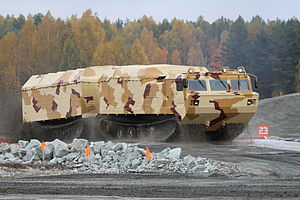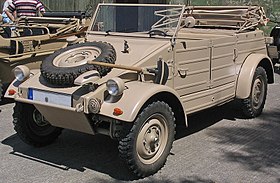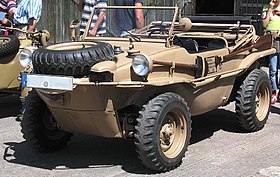
James Bond movies aside, the amphibious vehicle has never really caught on. You might associate an amphibious vehicle with a car, but bikes and buses can also be amphibious. Most are developed and used by the militaries of the world. Let’s take a closer look at some Russian, German and American amphibious vehicles.
From the former Soviet Union comes the Vityaz, a the multi-unit ATV and not truly amphibious because it doesn’t really float. It is, however, capable of carrying a monster payload (over 5 tons) through snow or swamp. The Vityaz resembles two carriages from a train with caterpillar tracks. While it’s predecessors go all the way back the the 1960’s the current model has been in production since 1982.
 The German car-maker Volkswagen brings us two offerings: the Schwimmwagen and Kübelwagen. The Schwimmwagen is a squat 4×4 and the Kübelwagen resembles the bottom half of a VW Beetle. Bothe descend from the civilian version of the humble VW Beatle, but the Kübelwagen came first. The Kübelwagen became the Axis version of the allies jeep, sort of an all-terrain swift transport and tow platform. Unfortunately, the bottom design didn’t lend itself to swimming, with lead to the later developed Schwimagen. Over 15,000 Schwimwagens were produced between 1941 and 1944, making it the largest number of amphibious vehicles ever produced.
The German car-maker Volkswagen brings us two offerings: the Schwimmwagen and Kübelwagen. The Schwimmwagen is a squat 4×4 and the Kübelwagen resembles the bottom half of a VW Beetle. Bothe descend from the civilian version of the humble VW Beatle, but the Kübelwagen came first. The Kübelwagen became the Axis version of the allies jeep, sort of an all-terrain swift transport and tow platform. Unfortunately, the bottom design didn’t lend itself to swimming, with lead to the later developed Schwimagen. Over 15,000 Schwimwagens were produced between 1941 and 1944, making it the largest number of amphibious vehicles ever produced.
 The Americans meanwhile developed the DUKW, which is where the story really twists.
The Americans meanwhile developed the DUKW, which is where the story really twists.
The DUKW Story
It isn’t that clear what the DUKW stands for, the official line is that the initialism concerns “Designed in 1942” and “Utility” but the K and the W don’t stand for much at all. It may just be thought of as a code name but if that’s so why come up with code name which resembles what they are?
The DUKW, from this point forward ‘Duck’ was developed by top military and naval pioneers and quickly rejected by the main forces. When several Coast Guards got into difficulty off the coast of Princetown in Massachusetts a Duck vehicle happened to be giving a demo. The vehicle had no difficulty in rescuing the stranded Guardsmen. Later the Duck would show its usefulness by crossing the English Channel as well as manoeuvring on French soil but firstly the initial vehicle was re-engineered by the Yellow Coach & Truck Company.
 Two thousand such vehicles were used by Great Britain during the WWII as well as 500 being used by Australian forces. Just over 75 years ago they were used in D-Day When the war ended they were used both in the Borneo and the Malayan campaign. These old vehicles seemed remarkably hard wearing, given that many had to undergo the rigor of the tide. The last Duck to be used in the military was in 2012.
Two thousand such vehicles were used by Great Britain during the WWII as well as 500 being used by Australian forces. Just over 75 years ago they were used in D-Day When the war ended they were used both in the Borneo and the Malayan campaign. These old vehicles seemed remarkably hard wearing, given that many had to undergo the rigor of the tide. The last Duck to be used in the military was in 2012.
There were plans to make Ducks bigger, to turn them into Superducks or “Drakes”. Developments were especially made in what was then the Soviet Union, including the addition of a ramp to the back of the vehicle, which would seem more like common sense than a physical difference.
How Floating Cars Help Regular Cars
As you might guess, there are many factors at play in creating amphibious vehicles that can be used in normal vehicles. Water in the engine is always a bad thing and the developments during the war and beyond were vital to keeping modern cars running smoothly. Then there is the difficulty of what happens when a car not exactly built for it has to drive through water.
The official recommendation is always to avoid driving your car through water deeper than a few inches but even car makers know it’s going to happen. Any water on the road, ford or puddle, may affect your brakes. After going through the water you are advised to check that your brakes work.
A ford is a place you cross a river where no bridge has been built. You should, at least, find a depth gage which marks the current depth of the water. Without a depth gage you’re advised not to try.
The Ultimate Demise of the DUKW
The final resting place in history for the “Duck Boat” has been tourism. Places like Seattle, Washington and Branson Missouri have employed them to take visitors around to see the sights from the unique views available to a vehicle that can go on land and water.
However, these tours have been plagued by tragic accidents, when taken out in adverse weather conditions or when poorly maintained. It will become increasingly more difficult to find an operational DUKW, but that doesn’t mean the world has given up on civilian Amphibious Vehicles.
Quite a few UTV’s are in production with limited amphibious ability, due in no small part, to their ability to help sport hunters and outdoor enthusiasts reach destinations that are otherwise nearly unattainable.